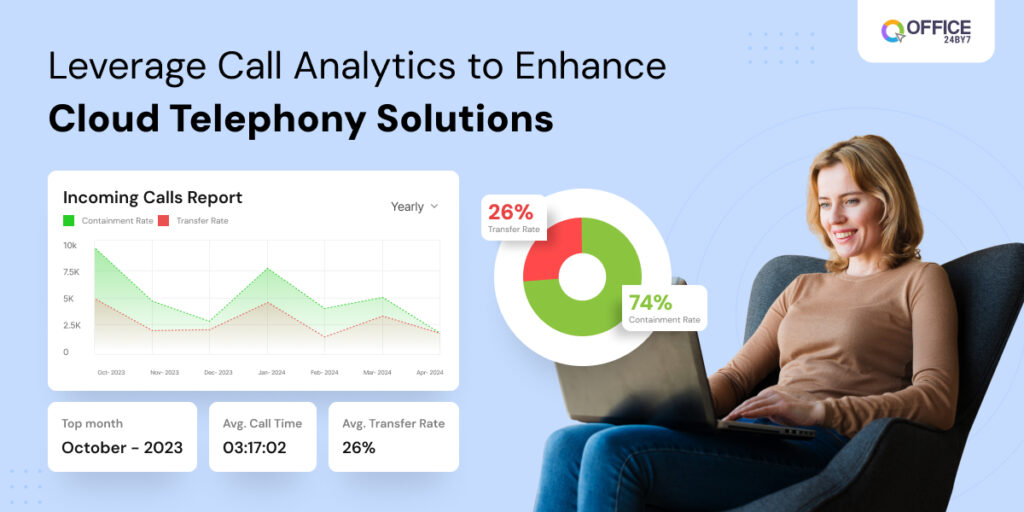
If you are working in the sales department of any organization, this question is for you: what kind of leads are the easiest to convert? Most people might answer website leads because they have already shown an interest by filling in their details in the form. A recent study by Forrester showed that 84% of marketers agree that phone calls have higher conversion rates with average order value (AOV) larger than other types of leads. Take a minute to process that number – a whopping 84%. The study also showed that leads from phone calls convert 30% faster than website leads. So how do we enhance the potential of cloud telephony solutions to achieve this increased conversion rate? The best way to do so is by optimizing your cloud telephony solutions by leveraging call analytics.
Call analytics is indeed an integral part of enhancing cloud telephony solutions. Analyzing the call data, caller demographics, containment rate, CSAT score, etc. can improve the potential for more growth. One of the several reasons for phone calls being more effective is that phone conversations give you more insights – even their personal information, needs, wants, and much more – that you can’t get from any other source. Agents get a chance to get to know what the leads actually want and how to personalize their approach. Effective communication is the cornerstone of sales conversions. Businesses still are in the starting phase of recognizing the value of call tracking and analytics in cloud telephony solutions. By the end of this article, you will gain a comprehensive understanding of how call analytics can be leveraged to optimize cloud telephony solutions and drive business growth.
An Overview of Cloud Telephony Solutions
Cloud telephony solutions brought a paradigm shift in the way businesses approach their potential customers. It is indeed a revolution in the communication infrastructure. Unlike traditional communication systems that extensively rely on physical hardware and infrastructure, cloud telephony solutions depend completely on the cloud using software-based solutions.
Features of Cloud Telephony Solutions
Cloud telephony leverages the principles of Voice over Internet Protocol (VoIP) technology to transmit voice calls over the Internet. This eliminates the need for costly hardware installations and enables businesses to scale their communication infrastructure seamlessly. This enables you to move from the traditional call center solution to the modern virtual call center solutions. Cloud telephony solutions also offer tremendous features and functionalities, including virtual number, Interactive Voice Response (IVR), call routing, call recording, and integration with Customer Relationship Management (CRM) systems and other tools. While virtual number, call center IVR systems, and call routing facilitate you to manage inbound calls via inbound call center services, CRM integrations enhance your outbound call center services by giving lead history, bulk actions, and options for lead nurturing.
Advantages of Cloud Telephony Solutions
One of the primary advantages of cloud telephony is its inherent scalability and flexibility. Businesses can easily add or remove phone lines, adjust call routing rules, and integrate additional features to suit their evolving needs. The cost of virtual call center solutions depends on the cloud telephony providers. There are many providers out there in the market who you could choose from. The best cloud telephony providers like Office24by7 offer you flexible plans and pricing, where you can choose plans based on factors like the number of users, features required, etc. This allows organizations to pay only for the services they consume, thereby minimizing upfront costs and optimizing operational expenses.
Cloud telephony solutions also enhance business continuity and resilience. Since the infrastructure is hosted in the cloud, businesses are insulated from on-site disruptions such as power outages or hardware failures. Calls can be seamlessly routed to alternative locations or devices, ensuring uninterrupted communication even in the face of unforeseen circumstances.
Definition and Importance of Call Analytics
In terms of cloud telephony solutions, call analytics (sometimes also referred to as business phone analytics) refers to the process of collecting, analyzing, and interpreting data generated from calls made from virtual call center solutions. In the context of virtual call center solutions, call tracking and analytics enable businesses to gain valuable insights into various aspects of their communication operations. These insights can encompass a wide range of metrics, including call volume, call duration, caller demographics, agent performance, call outcomes, and more.
Call analytics is the most important factor in bringing your communication efforts to success. The power of call data helps organizations make informed decisions and optimize their communication automation strategies. These decisions and strategies also drive operational efficiency. Here are some key reasons why business phone analytics are essential in leveraging cloud telephony solutions:
Performance Monitoring
Call tracking provides businesses with valuable insights into agent performance metrics such as call handling time, call resolution rates, and customer satisfaction scores (CSAT). By monitoring these metrics, organizations can identify areas for improvement, implement targeted training programs, and enhance overall service quality.
Customer Insights
Analyzing call data allows businesses to gain deeper insights into customer behavior, preferences, and pain points. By understanding customer needs more effectively, organizations can tailor their outbound calling solutions approach, optimize communication strategies of inbound and outbound call center services, personalize customer interactions, and improve customer satisfaction levels.
Operational Efficiency
Call analytics help businesses optimize their operational workflows and resource allocation. By identifying call patterns, peak call times, and call volume trends, organizations can allocate resources more efficiently, reduce wait times, and improve overall operational efficiency.
Campaign Effectiveness
For businesses running marketing or promotional campaigns, business phone analytics provide invaluable insights into campaign effectiveness. Best virtual business phone service helps track metrics such as call conversion rates, call sources, and call outcomes, organizations can measure the ROI of their campaigns, refine their targeting strategies, and optimize marketing spend.
Compliance and Security
Call analytics play a crucial role in ensuring regulatory compliance and data security. By monitoring call recordings, detecting anomalies, and flagging potential security threats, organizations can mitigate compliance risks, safeguard sensitive information, and maintain regulatory compliance.
Understanding Call Analytics in Cloud Telephony Solution
In the context of cloud telephony solutions, call tracking and analytics encompass a wide range of functionalities and capabilities. Modern cloud telephony platforms offer robust analytics tools and dashboards that empower businesses to gain actionable insights from their call data. Here are some key components of call analytics in the context of cloud telephony:
Call Detail Records
Call detail records capture comprehensive information about each telephone call, including the caller’s number, call duration, call outcome, and much more. Analyzing these records allows businesses to track call volumes, identify calling patterns, and measure key performance indicators.
Real-time Call Monitoring
Many cloud telephony providers offer real-time call monitoring capabilities, allowing supervisors to listen in on live calls. There are various other features that are relative to call monitoring, like:
- call whispering that allows supervisors to give instructions to agents on call, and
- call barging that allows supervisors to interrupt the call if necessary.
Real-time call monitoring enables businesses to provide immediate feedback, coach agents in real-time, and ensure consistent service quality.
Call Recording and Transcription
Cloud telephony solutions often include call recording features that allow businesses to record and store telephone conversations for quality assurance, training, or compliance purposes. Additionally, advanced transcription capabilities enable businesses to automatically transcribe recorded calls into text format, making it easier to analyze and search for relevant information.
Interactive Dashboards and Reporting
Modern cloud telephony platforms come equipped with interactive dashboards and customizable reporting tools that provide businesses with visual representations of their call data. These dashboards enable organizations to track key metrics, monitor performance trends, and generate custom reports tailored to their specific needs.
Integration with CRM Systems
Integration with customer relationship management (CRM) systems enables businesses to correlate call data with customer profiles, purchase history, and previous interactions. This holistic view of customer data allows organizations to deliver personalized experiences, anticipate customer needs, and drive customer loyalty.
Types of Tracking Metrics in Cloud Telephony Solutions
Analyzing the call data based on the tracking metrics might seem very easy, but there’s more to it. One should have a proper understanding of different call metrics used in cloud telephony solutions to properly understand the data. Let’s get familiar with some of the tracking metrics used in business phone analytics. A major part of virtual call center solutions is inbound call center services through IVR. So in this section, we’ll be mostly talking about metrics to be tracked from IVR. We’ll also discuss some metrics that can track the efficiency of outbound call center services.
Containment Rate
The containment rate measures the percentage of customer inquiries or issues that are handled entirely within the IVR system without needing to be transferred to a live agent. A high containment rate indicates that the IVR system effectively addresses customer needs, leading to reduced calls to live agents and improved operational efficiency.
Transfer Rate
The transfer rate reflects the frequency with which calls are transferred from the IVR system to live agents. Monitoring the transfer rate helps organizations evaluate the effectiveness of IVR routing strategies and identify opportunities to enhance self-service capabilities, ultimately reducing the burden on live agents and improving customer satisfaction. A high transfer rate could suggest:
- Callers in need of human intervention
- Gaps in IVR functionality
- Inadequate menus or unclear prompts
Opt-Out Rate
The opt-out rate measures the percentage of callers who choose to exit the IVR system and speak with a live agent instead or hang up. Monitoring the opt-out rate provides insights into customer preferences and satisfaction with the IVR experience. High opt-out rates may indicate issues with IVR usability or the need for additional self-service options.
Call Abandonment Rate
Call abandonment refers to the rate at which callers disconnect from the IVR system before reaching a resolution or speaking with a live agent. Monitoring call abandonment helps organizations identify potential issues with IVR navigation, system responsiveness, or call queue management, allowing them to implement improvements and reduce abandonment rates.
Average Call Duration
Average call duration or average handle time refers to the average duration of customer interactions with the IVR system, including navigating menus, inputting information, and receiving responses. Tracking average handle time helps organizations assess the efficiency of IVR interactions and identify opportunities to streamline processes and reduce customer wait times.
Customer Satisfaction Score (CSAT)
Customer satisfaction score (CSAT) measures the level of satisfaction or dissatisfaction among customers who interact with the IVR system. By collecting feedback from customers after their IVR interactions, organizations can gauge the effectiveness of the IVR system in meeting customer needs and identify areas for improvement.
Error Rate
The error rate indicates the frequency of errors encountered by callers during IVR interactions, such as misinterpreted inputs or system malfunctions. Monitoring the error rate helps organizations identify technical issues, improve IVR design and usability, and ensure a seamless customer experience. The error rate monitors technical glitches and breakdowns experienced during IVR engagements, including:
- Dropped calls
- Repetitive menus
- Timeouts
- Issues with integrating CRM
Call Volume
Call volume refers to the number of incoming calls handled by the IVR system within a specific timeframe. Tracking call volume enables organizations to anticipate peak periods and allocate resources efficiently. This ensures that the IVR system can handle fluctuating call volumes without disruptions.
Caller Demographics
Analyzing caller demographics provides insights into the characteristics of the individuals interacting with the IVR system. These characteristics include age, location, or preferred language. Organizations can have a diverse customer base. Understanding caller demographics helps them tailor IVR prompts and messages to better meet their needs and preferences.
Benefits of Leveraging Call Analytics
The strategic utilization of call analytics within cloud telephony solutions offers a multitude of benefits for businesses across industries. These benefits extend beyond improving operational efficiency to positively impact customer experiences, drive revenue growth, and foster long-term business success. Here are some key benefits of leveraging call tracking and analytics:
Enhanced Customer Experiences
By analyzing call data, businesses can gain deeper insights into customer preferences, behaviors, and pain points. This enables organizations to tailor their communication strategies, personalize customer interactions, and deliver seamless, frictionless experiences that drive customer satisfaction and loyalty.
Improved Operational Efficiency
Call analytics provide businesses with valuable insights into call volume trends, agent performance metrics, and operational workflows. Armed with this information, organizations can optimize staffing levels, streamline call processes, and allocate resources more efficiently, ultimately reducing costs and enhancing productivity.
Data-Driven Decision-Making
Call analytics empower businesses to make informed, data-driven decisions based on real-time insights. Whether it’s optimizing marketing campaigns, refining sales strategies, or improving customer service initiatives, leveraging call data allows organizations to identify trends, anticipate customer needs, and proactively address challenges.
Increased Sales and Revenue
By tracking metrics such as call conversion rates, sales teams can identify high-performing tactics, optimize sales scripts, and prioritize leads with the highest likelihood of conversion. This enables organizations to maximize sales effectiveness, drive revenue growth, and capitalize on new business opportunities.
Compliance and Risk Mitigation
Call analytics play a crucial role in ensuring regulatory compliance and mitigating risks associated with data security and privacy. By monitoring call recordings, detecting anomalies, and identifying potential security threats, organizations can proactively address compliance issues, safeguard sensitive information, and protect their brand reputation.
Continuous Improvement
By continuously monitoring and analyzing call data, organizations can identify trends, track performance metrics, and measure the impact of process improvements over time. This enables businesses to iterate on their communication strategies, implement targeted interventions, and drive continuous optimization of their cloud telephony solutions.
Strategies for Effective Implementation of Call Analytics
Implementing business phone analytics within virtual call center solutions requires careful planning, strategic execution, and ongoing refinement to maximize its effectiveness and impact on business outcomes. Here are some key strategies for effectively implementing call analytics:
Define Clear Objectives
Begin by defining clear objectives and key performance indicators (KPIs) that align with your business goals. Having well-defined objectives will guide your call analytics implementation strategy and help measure its success. This will help you improve customer satisfaction, increase sales conversions, or optimize operational efficiency,
Select the Right Metrics
Identify the specific metrics and data points that are most relevant to your business objectives. Focus on metrics that provide actionable insights into call volume, call duration, agent performance, customer satisfaction, and other key performance indicators. Tailor your analytics approach to capture the data that matters most for driving business outcomes.
Choose the Right Technology
Select a cloud telephony platform that offers robust business phone analytics capabilities. It should integrate seamlessly with your existing systems and workflows. Features such as call monitoring and integration with CRM systems to maximize the value of your call analytics investment.
Implement Quality Assurance Processes
Establish quality assurance processes to ensure the accuracy and reliability of your call data. This may involve regularly auditing call recordings and implementing protocols for handling sensitive information in compliance with regulatory requirements.
Provide Ongoing Training and Support
Invest in training and development programs to ensure that employees understand how to effectively use business phone analytics tools. Provide ongoing support and guidance to help teams leverage call analytics to improve their performance and achieve business objectives.
Promote a Data-Driven Culture
Foster a culture of data-driven decision-making within your organization by promoting the use of call analytics across departments and teams. Encourage collaboration, knowledge sharing, and cross-functional alignment to ensure that insights derived from call analytics are integrated into strategic planning and day-to-day operations.
Iterate and Improve
Continuously monitor and evaluate the effectiveness of your business phone analytics initiatives. Be prepared to iterate and refine your approach based on feedback and performance metrics. Regularly review your objectives, adjust your strategies as needed, and seek opportunities for innovation and improvement.
Stay Compliant and Secure
Ensure compliance with relevant regulations, such as data privacy laws and industry-specific regulations governing call recording and data handling. Implement robust security measures to safeguard sensitive information and mitigate risks associated with data breaches or unauthorized access.
Conclusion
Call analytics in cloud telephony solutions helps organizations reshape the way they engage with customers. Throughout this article, we’ve explored why call analytics is so important in order to make the most out of cloud telephony solutions. Cloud telephony solutions transform the communication infrastructure. Businesses can transcend traditional communication barriers and embrace seamless communication with the scalability and flexibility of the cloud. Cloud telephony solutions help deliver efficient communication experiences with features such as call center IVR systems, call routing, call recording, etc.
The true growth potential of cloud telephony solutions can only be leveraged with robust call analytics. As we’ve discovered, call analytics enable businesses to glean valuable insights from their communication data. It can provide you with agent performance metrics and customer behavior patterns. By leveraging these insights, organizations can make informed decisions and optimize their communication strategies.
The staggering statistics shared earlier underscore the significance of call analytics in driving business success. The impact of call analytics on key business metrics is undeniable. Despite its immense potential, many organizations are yet to recognize the value of call analytics in cloud telephony solutions.
Call analytics is not just a tool but a catalyst for innovation and growth in cloud telephony solutions. With efficient call analytics, organizations can unlock new opportunities for enhancing customer experiences, improving operational efficiency, and driving bottom-line results. It’s clear that call analytics in cloud telephony solutions redefine the way businesses communicate. Cloud telephony providers like Office24by7 provide you with advanced call analytics. You can use this to optimize your call center performance and operational efficiency.
#CloudTelephonySolutions #CallAnalytics #VirtualCallCenterSoftware #CustomerSatisfaction #BusinessPhoneAnalytics #CloudTelephonyServiceProviders





